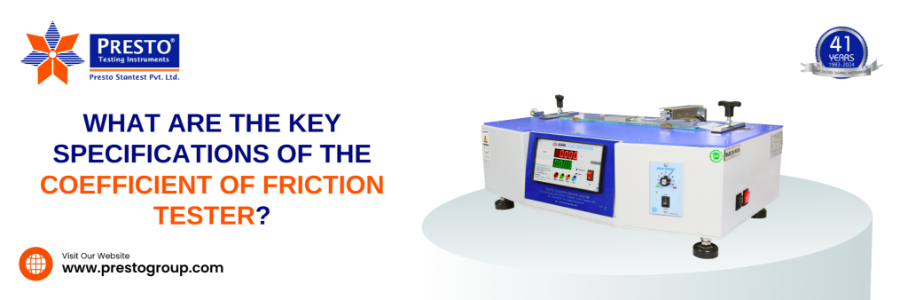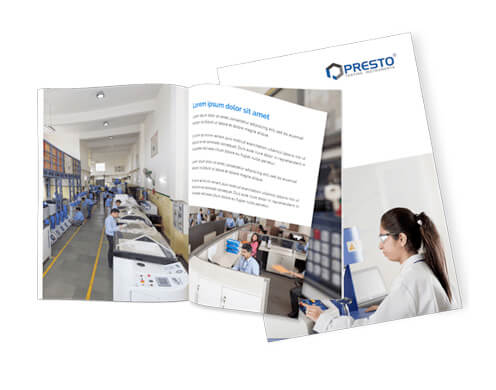What are the Key Specifications of the Coefficient of Friction Tester?

In the realm of packaging, where material performance takes precedence, the utilization of a coefficient of friction tester is indispensable. Packaging materials must delicately balance ease of handling during manufacturing and transportation with the imperative for stability and security during storage and utilization. The coefficient of friction holds a direct sway over the seamless movement of packages along conveyor belts, the efficacy of packaging machinery, and the prevention of slips and slides during stacking and storage.
Evaluating the coefficient of friction tester for plastic films necessitates the utilization of a sophisticated testing tool known as a coefficient of friction tester. This advanced equipment is instrumental in assessing the friction resistance properties of plastic films. Through accurate measurements of the coefficient of friction, packaging engineers can strategically refine their material selection and design, ultimately leading to heightened functionality and enhanced cost-effectiveness.
Whether it involves the selection of the optimal material combination for a food packaging film or ensuring the smooth operation of high-speed packaging lines, a coefficient of friction tester emerges as an invaluable asset.
Ultimately, the integration of this testing laboratory testing instrument within the packaging industry contributes significantly to elevated product quality, heightened efficiency in manufacturing processes, and the overall dependability of packaged goods in the market.
Why packaging manufacturers must use co-efficient of friction tester?
Testing the friction value of plastic films helps manufacturers in ensuring the quality of materials and help manufacturers in testing the slip resistance of plastic surfaces. This parameter will quantify the ratio of force required to move one object over another in relation to weight or force pressing them together.
Essentially, it measures the resistance between two surfaces when one undergoes sliding or rubbing against the other.
The measurement of COF holds paramount importance across a spectrum of industries, encompassing manufacturing, construction, automotive, and consumer goods. Its role extends to ensuring product quality, compliance with safety standards, and a general enhancement in performance. Delving deeper, let's explore the criticality of measuring COF without delving into the intricacies of artificial intelligence:
1. Control of Product Quality:
For companies engaged in the production of goods involving surface interaction or movement (e.g., packaging materials, tires, flooring materials), maintaining consistent COF levels is imperative. COF measurement serves as a means to guarantee that products adhere to specific friction requirements and perform as anticipated. Inconsistencies in COF may lead to defects such as slippery floors or inadequate tire grip, resulting in accidents and potential legal issues. Regular COF measurement during production is, therefore, a vital practice to ensure only high-quality products reach consumers.
2. Compliance with Safety Standards:
The comprehension and maintenance of appropriate COF levels play a crucial role in ensuring compliance with workplace safety standards across various industries. With the regular and continuous use of co-efficient of friction tester manufacturers can easily and accurately test the frictional value of the materials and helps manufacturers in ensuring quality of materials to be delivered to the customers.
3. Enhancement of Performance:
COF measurement aids in identifying avenues for performance improvement in diverse industries. Automotive companies, for instance, employ COF measurements for tires to optimize design and materials, enhancing traction on roads. Similarly, manufacturers of cleaning products utilize COF testing to evaluate product effectiveness in reducing friction between surfaces, facilitating the improvement of formulations and the provision of more efficient solutions.
The friction testing machine can effectively be used to make informed decisions about material selection, production processes, and product development to effectively meet consumer needs. Regular COF measurement and monitoring will help packaging manufacturers in ensuring accuracy in lab testing results.
Now, let us discuss the key specifications of this quality testing instrument.
Key specifications of co-efficient of friction tester
The technical specifications of the friction tester unveil critical insights into its performance and precision. The coefficient of friction serves as a key indicator, delineating the extent to which a sheet can undergo movement without compromising the integrity of labels and prints.
The instrument boasts a robust Maximum Capacity of Load Cell at 3 Kgf, ensuring its capability to accurately measure friction forces. The Digital LED Display provides clear visibility and ease of reading, enhancing user experience.
With an impressive Device Accuracy of ± 1% across the entire range, the friction tester guarantees reliable and consistent results. The high-resolution capability, with a Resolution/Least Count of 0.1 gm, further contributes to its meticulous measurement accuracy.
Operating on a power supply of 220V, Single phase, 50 Hz, and featuring a Speed of 150 ± 30 mm/min, the device is designed for efficiency. The motor, a 1/4 HP Single Phase, with a speed of 1440 rpm, ensures smooth and controlled testing processes. Together, these specifications underscore the friction tester's capability to deliver precise and reliable assessments of material friction characteristics in diverse applications.
With these technical specifications, manufacturers can easily and accurately conduct friction test on the materials and ensure accuracy in lab testing results.
Conclusion
In conclusion, understanding the key specifications of a coefficient of friction tester is paramount for industries reliant on precise material interactions. The tester's ability to measure friction, with features such as a 3 Kgf Maximum Load Cell, 0.1 gm Resolution, and ± 1% Accuracy, ensures meticulous assessments. The Digital LED Display enhances visibility, while the 1/4 HP motor guarantees efficiency at 1440 rpm. The importance of these specifications extends beyond technicalities; they empower industries to make informed decisions, optimize material choices, enhance product quality, and ultimately improve performance. As a pivotal tool in material science, the coefficient of friction tester becomes indispensable for achieving reliability and precision in diverse applications. If you want to know more about this quality testing equipment, like coefficient of friction tester price then you can give us a call at +91-9210903903 or email us at info@prestogroup.com.
Author : -Gaurav Malhotra
Recent News
- Paper & Packaging Testing Instruments
- Paint, Plating & Coating Testing Instruments
- Plastic & Polymer Testing Instruments
- Environmental Testing Chambers
- PET & Preform Testing Instruments
- Color Measuring Testing Instruments
- View Entire Range Instruments

Catalogue 2023
Get information about new product launches, research, innovation and endeavors at Presto.
download Free CopyNeed more information
Connect with us for your business enquiries. Generally we respond within one or two working days.
send enquiriesContact Us
Quick quote
